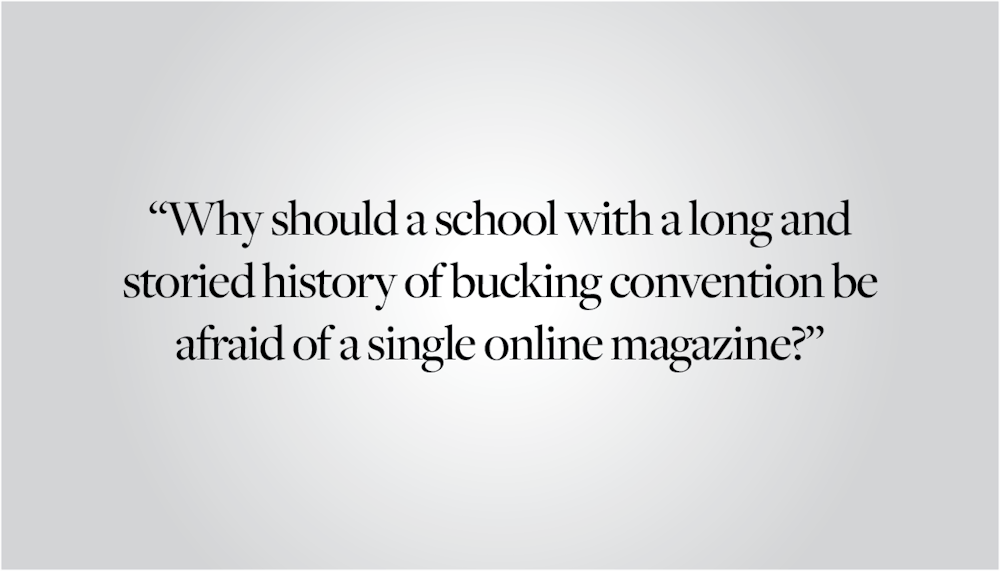The Warren Alpert Medical School recently announced it would stop submitting data to U.S. News and World Report for its “Best Medical Schools" rankings. In an open letter, Mukesh Jain, senior vice president for health affairs and dean of medicine and biological sciences, wrote that “rankings do not adequately capture the quality of education nor the level of support provided to students at any medical school.” We applaud the administration’s decision — this change is an important step toward aligning the University’s practices with its ideals. But let’s not stop at medical school rankings.
Jain stated that after extensive consideration, the administration at Warren Alpert “reached the conclusion that the approach upheld by the U.S. News rankings simply does not align with our institutional values.” But only considering medical school rankings through this lens sets a double standard. Undergraduate college rankings are equally flawed and deserve the same criticism Jain levies on medical school rankings. They arbitrarily assign numerical values to institutions of higher education and feed a vision of college as a hierarchical rat race. And yet, in a recent press release, the University boasted its high placement across lists ranking undergraduate student experiences and high-impact instruction. Are the values of Warren Alpert so different from those of the College?
U.S. News’s college rankings are perhaps the most followed; they help to color popular perceptions of prestige and quality. In theory, rankings might be a good idea. Navigating the American college landscape can be overwhelming because there is such great diversity among institutions, from large, research-heavy state schools to small, liberal arts colleges. Ordering the vast world of higher education could help confused high school seniors prioritize their interests. Schools like Brown also benefit extensively from these rankings — they keep attention focused on us. And our allegiance to U.S. News paid off this year: Brown achieved its highest rank since 1997.
But it is exactly the attempt to standardize this variety that is concerning. U.S. News assigns varying weights and percentages to different elements of college life. There are many factors in these rankings that should give readers pause. A reputational survey, which asks administrators for their opinions on peer institutions, comprises a whopping 20 percent of schools’ scores. While those working in higher education should theoretically have a better sense of their peers’ quality, it seems methodologically dicey to ask them to numerically rank dozens of institutions. This metric serves to reinforce prior conceptions of a premium education and leaves little room for newcomers. Additionally, U.S. News factors in faculty salaries, per-student spending and alumni donations, which are essentially just measures of institutional wealth. It also considers student SAT scores, which detractors have argued are tied to higher incomes. Rankings also rely on universities to submit data, which can lead to unreliable figures. The numbers under the hood, evidently, have severe flaws.
The weight of these factors on rankings shifts frequently, leading to huge swings from year to year. The educational quality of these colleges isn’t significantly changing in the span of 12 months, yet schools can rise and fall with alarming speed. Rankings are thus not only subjective but also unstable.
U.S. News continues to adjust its process in an attempt to respond to critiques. It has placed more weight on outcomes in recent years. But rankings fundamentally make college a zero-sum game. This year, minor tweaks led to large public universities moving up significantly. Of course, these changes came at the expense of other schools, which have criticized the latest rankings. Any shift in measurement will not be enough to fairly quantify hundreds of schools.
There’s momentum across higher education in support of ending rankings participation. Warren Alpert followed a host of peers in law and medicine and we wouldn’t be the first to leave undergraduate rankings, either. Reed College pulled out of undergraduate rankings in 1995. In the past year, Bard College, Colorado College, Columbia and the Rhode Island School of Design departed as well.
U.S. News will likely continue to rank Brown, as it did with those who left, regardless of the University’s decision. But it’s a matter of values. Halting active administrative participation in the rankings would be an important symbolic move and could catalyze movement among our peers. We’ve led the way before — we were one of the first universities to grapple with our institution’s ties to slavery. And we upended the traditional model of higher education with the open curriculum. Why should a school with a long and storied history of bucking convention be afraid of a single online magazine?
Editorials are written by The Herald’s editorial page board and aim to contribute informed opinions to campus debates while remaining mindful of the group’s past stances. The editorial page board and its views are separate from The Herald’s newsroom and the 133rd Editorial Board, which leads the paper. This editorial was written by the editorial page board’s editors Kate Waisel ’24 and Devan Paul ’24, as well as its members Paulie Malherbe ’26, Alissa Simon ’25, Rachel Thomas ‘25 and Yael Wellisch ’26.





